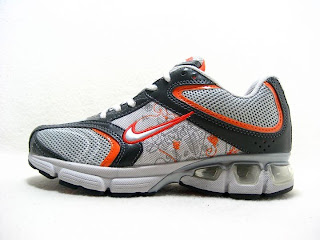 Today I wanted to give you a little insight on running/walking shoes. Here is some very valuable information to keep in mind when shoe shopping. Remember that everyone has different feet and they respond differently when they hit the ground depending on anatomy of the individual's foot, muscle flexibility, joint alignment, and muscle strength. Physical therapists can evaluate your foot and running techniques to help you properly find the best footwear for you!
Today I wanted to give you a little insight on running/walking shoes. Here is some very valuable information to keep in mind when shoe shopping. Remember that everyone has different feet and they respond differently when they hit the ground depending on anatomy of the individual's foot, muscle flexibility, joint alignment, and muscle strength. Physical therapists can evaluate your foot and running techniques to help you properly find the best footwear for you! Vamp - The front portion of the shoe leading from the arch region up toward the toes
Throat - The place where the tongue meets vamp
Collar - The top rim portion of the shoe
Tongue - The material that lies under the laces
*Heel counter
- The stiffened material that is curved around the heel
Inlay - The
removable liner found within the shoeMidsole - The mid portion of the sole of the shoe generally made out of cushioned foams materials in athletic shoes
Outsole - Generally constructed from durable materials including leather and rubber
Reference:
sanluispodiatrygroup.com
What to look for in running/walking shoes:
1.
Type of shoe – Cushion, Stability, Motion
Control (discussed on back side)
2.
Amount of arch support – recommend support for
arch that does not collapse easily with activity
3.
Heel Counter – Important to have stiff heel
counter for people with ankle stability issues and increased pronation
4.
Toe Box – Must be wide enough so that your feet
have room to expand with each step, however, should not be too loose because
foot can slide around too much if shoe is too wide
5.
Must be COMFORTABLE! – You must like the fit and
comfort of the shoe so that your feet are happy with the choice you make in
footwear
Types of Running/Walking Shoes:
1. Cushion Shoes: Your typical every day running or walking
shoes that are comfortable to wear, but offer minimal support. Best for people
that have arches that do not collapse when walking or running. Not recommended
for people that pronate or have flat feet.
2. Stability Shoes: Running or walking shoes that offer
moderate support in the midsole of the shoe. These are best for people that
have arches that collapse (increased pronation) with walking or running. The midsole has duo-density foam that
provides increased density near the arch to absorb impact when people
pronate.
3.
Motion Control Shoes: Running or walking shoes that offer
maximum stability in the midsole of the shoe. These are best for people that
have arches that completely drop with walking or running, have poor ankle
stability, and too much ankle mobility. Not recommended for people that are
avid runners.
Shoe Facts:
·
Structural damage of the shoe occurs after 121 miles of use
o Loss
of shock absorption of the shoe:
§ 25%
at 50 Miles
§ 33%
at 150 Miles
§ 45%
at 500 Miles
·
Length of shoe should be ½ inch longer than
your longest toe
·
Width should be determined by widest portion of
the midfoot (region near ball of foot)
·
Heel fit should be snug against your foot
·
Shoes should be comfortable – not everyone can
benefit from increasing the stability in their shoes and it all depends on
running form, strength, joint stability, and the individual’s foot
Most Common
Running Injuries (Study by Taunton et al):
·
Patellofemoral Pain Syndrome
·
Iliotibial Band Friction Syndrome
·
Plantar Fasciitis
·
Tibial Stress Fracture
·
Knee Meniscal Injuries
Risk Factors
for Running Injuries (Studies by Taunton et al, McKean, Bulst et al, Macera
et al, Marti et al, and van Mechelen):
·
Running experience: you are 2.5-3x more likely to be
injured without prior running experience
·
Rapid increase in mileage or intensity:
If you are exceeding 40 miles/wk it will put you at 3x the risk of becoming injured
·
Competitive training motive: you are likely to ignore
early injury symptoms if you are competitive
·
Incidence of injury may increase with age and
location of injury changes with age
·
Males are 1.5x more likely to be injured than
females
Key Muscles to
Strengthen if You’re a Runner:
·
Quadriceps
·
Hamstrings
·
Gluteus Maximus
·
Gluteus Medius
·
Gastrocnemius/Soleus
·
Hip Flexors
·
Gastrocnemius
·
Hip Adductors
·
Piriformis
|
References:
·
Bryan Heiderscheit, PT, PhD – University of
Wisconsin-Madison PT677 Clinical Management of Common Running Injuries Lecture
·
Above studies as listed in headlines and Google
Images for photos of shoes




I’m going to read this. I’ll be sure to come back. thanks for sharing. and also This article gives the light in which we can observe the reality. this is very nice one and gives in-depth information. thanks for this nice article.
ReplyDeletebest footwear for men